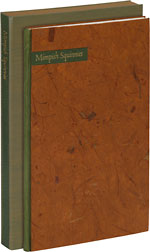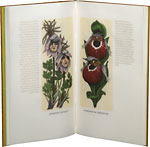At Home in the Natural World
Rorer decided that her next book for Lone Oak Press would be based on the writings of the eccentric British garden writer, Reginald Farrer (1880-1920), whose wit and outlandish dismissals of certain plants tickled Rorer’s fancy. She chose to cull her text from Farrer’s book, The English Rock Garden, which was published in 1919. “His [Farrer’s] writing style was flamboyant and opinionated,” Rorer said. “He painted pictures of plants with words, with some of the descriptive words fabricated but making complete visual sense nonetheless. Hence, the title of my book is Mimpish Squinnies , two of Farrer’s unique descriptive words.” Here’s the passage of Farrer’s that caught Rorer’s eye: “Many of the race are very miffy or very mimpish or both…V. nivalis is another of the valueless little dirty sad-blue sqinnies.” Mimpish Squinnies was published in 2008.
We now arrive at that career-altering mistake alluded to at the beginning of the article. It centers on the woodblock engravings Rorer made to illustrate the book. “Originally, I had planned to hand-color the woodblock engravings that illustrate the book,” Rorer said. “But when I tried that, I found that the watercolor bled through the paper.”
In case you’re wondering, Rorer had, in fact, tested the watercolors on a small sample of the paper she wanted to use, Kozo-shi, which is made in Japan from mulberry trees. When she printed her woodblocks, the black and white bled through a bit. This didn’t worry her too much. But then: disaster. When she began hand-coloring the prints, “large areas of color bled everywhere and through the paper. I panicked. The pages were printed, the money was spent and I couldn’t do as I had planned with the engravings. What to do?”
‘Many of the race are very miffy or very mimpish or both.’
What to do was to learn an entirely new technique. “I determined that I would have to use multiple color blocks for each engraving, the large areas of color each having its own block.” The one tiny obstacle to this plan was that Rorer didn’t know how to make multiple color blocks. So, she taught herself. “I studied Gaylord Shanilec’s technique,” she said. [See www.midnightpapersales.com; and FB&C September/October 2006] “I even called him up for advice. I looked at prints by other wood-engravers who worked in color such as Rudolph Ruzicka and Paul Kershaw.”
And then?
“At this point there was only one thing to do—just do it.”
With much trial and error—and fortuitously learning, in a conversation with another artist, that the addition of gum arabic to ink impeded it from running—Rorer produced, a bit off schedule, the sixteen engravings that illustrate Mimpish Squinnies . She was inspired by the “anthropomorphic and animalistic” qualities of Farrer’s descriptions, and so produced, in her own words, “some quite unusual botanical illustrations.” You could say that. Wizened human heads grow out of one plant, claws out of another, while a third has a stalk comprised of a skeletal leg, and menacing Great White Sharks, mouths agape, teeth brandished, populate still another.
Even if these content of the illustrations is not your cup of high tea—and I have to say it is not mine—the power and accomplishment and pure artistry of the engravings is undeniable. When I talked to Rorer on the phone about this, I just blurted out, “But…this is amazing. How did you get so good your first time out?” I don’t remember her exact reply, except that it was couched in modesty. You look at these prints, and you think, this woman can do anything. This is what prompted Barry Moser to add to his praise, “She was a student of mine, but that term seems terribly out of place these many years later. Especially since she has gone on to outstrip the old man at his own game.”
Up next for Abigail Rorer will not be a book for Lone Oak Press. She is in the midst of illustrating Walt Whitman’s Leaves of Grass for the Folio Society, for whom she illustrated Dracula (2008). After that, she is planning to do a book with poems by Robert Frost for Lone Oak, drawing from an extensive collection of Frost material held in private hands. “We haven’t chosen the poems yet,” she said. They’ll be about nature. I have a promotional piece from his publisher from the 1930s, titled “From Snow to Snow.” Is that wonderful? I can’t wait to get started.”









